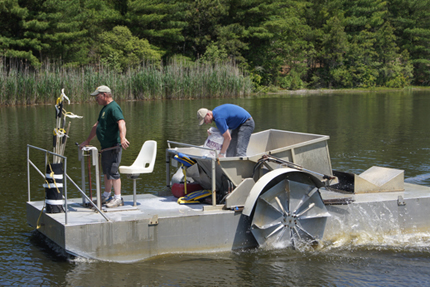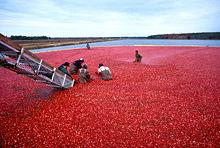It's not an uncommon situation faced by farmers: using additives to boost crop production, which then generates an unwanted problem down the line.
Solutions vary, depending on the specific dilemma. But in the case of cranberries, and how they are harvested in southeastern Massachusetts and the environmental issues the process can create, the answer in this instance is both sensible and straightforward.
The answer is chemistry.
Cranberry growers use lots of water, a process that floats the berries in the field and makes them easier to gather. Beforehand, to increase production often they add fertilizer that's rich in phosphorus, but that chemical is included in the farm-water runoff that makes its way downstream to lakes. However, too much phosphorus in lakes can produce oxygen-killing algae, which can suffocate fish while causing other harm to the local ecosystem.
Observing this problem, a researcher from the U.S. Department of Agriculture came up with several salt-based compositions that would interact with, and trap the phosphorus, reducing the amount contained in the water runoff. Of the five chemical compounds considered, "researchers concluded aluminum sulfate seemed to be the best salt suited to the task," according to a statement released Wednesday by the American Society of Agronomy. "Aluminum sulfate was effective in reducing phosphorus by 78-93% when applied at a concentration that is cost-effective for farmers to use."
Which was also an important objective; arriving at a solution that could be easily applied.
 “One of our goals was to help growers manage phosphorus loss on their own,” said the USDA's Casey Kennedy, who conducted the research in two ponds with colleagues from the Agricultural Research Service and the University of Massachusetts. “So the study was conducted using methods that could easily be used by growers.”
“One of our goals was to help growers manage phosphorus loss on their own,” said the USDA's Casey Kennedy, who conducted the research in two ponds with colleagues from the Agricultural Research Service and the University of Massachusetts. “So the study was conducted using methods that could easily be used by growers.”
The adjacent photo, courtesy of Kennedy, shows researchers distributing aluminum sulfate to a holding pond. "The ponds were located on cranberry farms in the towns of Carver and Plymouth, which combined for one-third of the state’s cranberry production in 2011," according to the authors of the study, which was published recently in the Journal of Environmental Quality.
As for the chemistry itself, Kennedy's solution gets some praise and a big thumbs-up from us, as well.
"The use of aluminum sulfate makes sense both chemically and agriculturally," says Dr. Josh Bloom, ACSH's Senior Director of Chemical and Pharmaceutical Sciences. "First, it acts as a phosphate scavenger by converting soluble phosphate to aluminum phosphate, which is highly insoluble in water and forms an inert precipitate.
"Second, aluminum sulfate is already used as a fertilizer so an unknown product is not being introduced into the environment. It acidifies soil and is useful for plants, such as blueberries, which prefer a low pH environment. Pretty clever stuff."
As we noted in a recent article, there's a nationwide algae-bloom problem that's growing in scale. So any measures to limit algae growth and help scale back this pressing issue are more than welcome.




